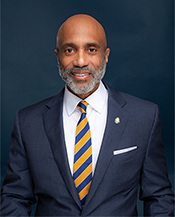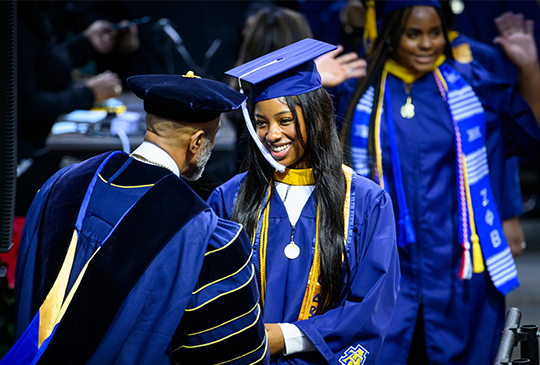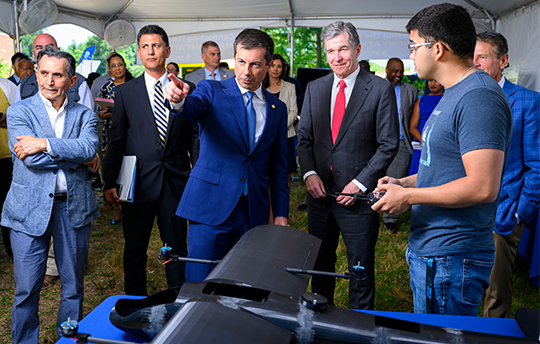|
 Technology will serve as the cornerstone of a future unlike any we have experienced before. Organizations that use technology to create deeper and more meaningful human relationships will rise to the top.
Technology will serve as the cornerstone of a future unlike any we have experienced before. Organizations that use technology to create deeper and more meaningful human relationships will rise to the top.

On the morning of my second day as chancellor of North Carolina Agricultural and Technical State University, I had the opportunity to address a campus-wide gathering of faculty and staff, the traditional start of the school year we call Faculty/Staff Institute.
It was my first chance to see most of my new colleagues, and they, me. While such events are often lighthearted and enthusiastic, it didn’t take long for us to get down to more serious business: the vision we are now developing for North Carolina A&T – a university distinguished by some of the most interesting, unique and exciting characteristics in all of American higher education. If I could boil my message down to two ideas, it would be these:
- Our perspective will expand, from national to global as we leverage new opportunities that the university’s evolution over the past 133 years now places within our reach.
- Our journey toward our goals will move at an exponential pace, driven not just by new and emerging technology, but by our ability to leverage people and partnerships and intersect information flows in ways that create new opportunities for our success at one of the most exciting doctoral research universities in America.
That might sound like a tall order. To understand it, we need to look beyond the “what” and examine the “why.”
First, North Carolina A&T is ranked the No. 1 public historically Black university in America by The Wall Street Journal with the second highest peer score among all HBCUs in U.S. News & World Report. We are also the largest HBCU in America for the past 11 consecutive years; more than 47,000 students sought admission to our university this academic year. We stand for something that students want: Outstanding academic preparation in a diverse, inclusive, cultural environment different from most other institutions of our size and stature.
Second, while we are currently designated an R2-High Research Activity institution, we surpassed criteria for the R1-Very High Research Activity classification in 2023-24 and will add to those qualifications this academic year. Over the past two years, our faculty have earned $250 million in contracts and grants and are rapidly expanding our capacity with new centers of excellence and partnerships with other research universities, corporations and federal agencies.
Third, our impact already reaches well beyond the United States. More than 100 nations are represented in our student body of 14,311 – 28 of them on the African continent. We are increasingly invested in important, consequential research that advances the human condition in Africa, from understanding the impacts of climate change and environmental pollution to enhancement of food supply chains to get sustenance more efficiently from suppliers to the starving and food insecure. Our foundation on a continent whose working-age population will grow by 450 million people over the next 10 years is exceptionally strong.
These characteristics might not be that noteworthy, were it not for new technologies that are shrinking the world and speeding the pace of innovation – technologies we are investing in as a university from instructional and research standpoints. Consider three recent examples:
- A&T is the lead institution in a new center of excellence in air mobility and drone innovation with initial funding of $2 million from the N.C. Dept. of Transportation.
- An interdisciplinary team of A&T researchers recently landed a $4.5 million U.S. Dept. of Education grant to expand our university’s research and teaching capacity in the biomedical life sciences.
- And in November, the UNC System Board of Governors approved our new B.S. in Artificial Intelligence – the first such degree in our state and one of only a handful nationwide.
There’s more – much more – and it all adds up to an unmistakable conclusion: A&T is emergent as an exponential university and has the cultural, academic and research bona fides to move intentionally in an exciting new direction that holds dramatic promise for our university and our students. While technology will serve as a cornerstone of that movement, our human and knowledge infrastructure and capacity to establish consequential relationships will be what sets us apart.
We live in a rapidly changing, dynamic world, one in which the importance of technological infrastructure has evolved to pay enormous rewards to those who understand that intersecting flows of information are the arena for game-changing innovation. A revolutionary future beckons, one unlike any we have ever experienced. We embrace the opportunity to lead in that new reality, from technological and human perspectives, mens et manus, mind and hand.
James R. Martin II, Ph.D., is the 13th chancellor of North Carolina A&T State University, America’s largest HBCU and one of the top three public research campuses of North Carolina.
|



 + Read more at https://www.ncat.edu/news/2024/11/aa-graduation-rankings.php
+ Read more at https://www.ncat.edu/news/2024/11/aa-graduation-rankings.php

 + Read more at https://www.ncat.edu/news/2024/12/ncdot-university-transportation-center-air-mobility-drone-innovation.php
+ Read more at https://www.ncat.edu/news/2024/12/ncdot-university-transportation-center-air-mobility-drone-innovation.php

 + Read more at https://www.ncat.edu/news/2024/11/coaach-nih-grant-alzheimers-disease.php
+ Read more at https://www.ncat.edu/news/2024/11/coaach-nih-grant-alzheimers-disease.php



 Technology will serve as the cornerstone of a future unlike any we have experienced before. Organizations that use technology to create deeper and more meaningful human relationships will rise to the top.
Technology will serve as the cornerstone of a future unlike any we have experienced before. Organizations that use technology to create deeper and more meaningful human relationships will rise to the top.
 A&T is the No. 1 producer of Black bachelor’s degree earners in all disciplines combined.
A&T is the No. 1 producer of Black bachelor’s degree earners in all disciplines combined.

 African Americans are twice as likely to develop Alzheimer’s disease as non-Hispanic whites.
African Americans are twice as likely to develop Alzheimer’s disease as non-Hispanic whites.
